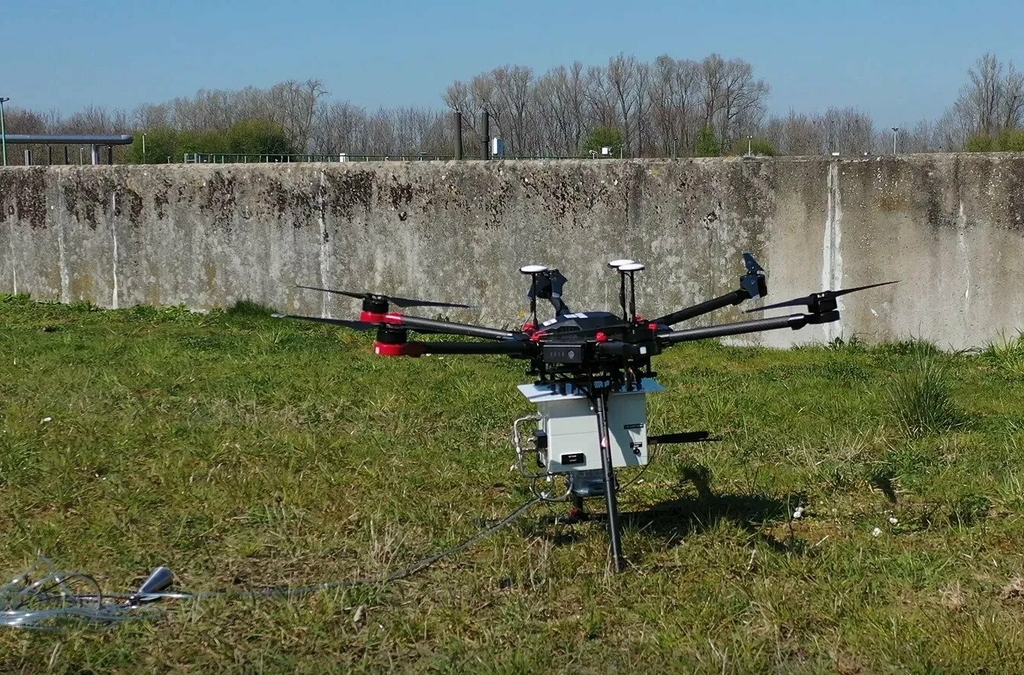Your web browser is out of date. Update your browser for more security, speed and the best experience on this site.
Determining emission and deposition with a flying lab
Our flying lab allows us to determine emission and deposition for large surface sources.

Introduction
Determining the emission and deposition impact of large emitting surface sources (such as biofilters or wastewater treatment basins) through classical manual measurements is often insufficient for obtaining representative and uniform emission data from the entire surface. This is because conventional measurements are time-consuming, and too limited for sampling the entire area efficiently.
To enable emission-determination of such sources, OLFASCAN has a flying lab available that can efficiently measure emission concentrations in time and space using on-board electrochemical sensors.

Drone and sensor technology
The sharp advancement of drone technology has created the ability to map hard-to-reach places, large areas and dangerous zones. The most well-known application is imaging and analysis where the drone is equipped with high-end cameras. Together with Drone Division, OLFASCAN has invested in an application where a lab with electrochemical sensors is mounted to a drone.
Chemical sensor technology in the lab allows accurate measurement of emission concentrations of NH3, H2S, O3, NO2, CH4, VOC, among others. Sampling air is drawn in through a long duct of inert material, and sent over the sensors. This allows the drone to operate safely, thereby minimising the effects of downdraft. The emission data can be monitored in real time, and the data is provided with GPS coordinates and time data.

Emissions and deposition – flux window
The emission load must be estimated in order to determine the deposition impact of emitting surfaces. A technique commonly used for this is the flux window method, which involves sampling two imaginary flux frames upwind and downwind. The emission load can be calculated based on the concentration difference, and the flow rate through the flux windows.
The flux window method thus requires emission concentration-determination in both a vertical and horizontal profile, to which drone and sensor technology lend themselves excellently.

NH3 load from a sludge post-sedimentation tank
To determine the NH3 load of a sludge post-sedimentation tank, the flux window method was performed using the OLFASCAN flying lab. A proprietary meteorological mast set up next to the settling tank indicated the dominant wind direction and prevailing wind speed, so that the imaginary flux window could be correctly constructed.
In both windows, NH3 concentration was measured horizontally and vertically over 21 points. On average, the NH3 concentration upwind was 1.56 ppm and downwind was 2.15 ppm, resulting in a concentration difference of 0.59 ppm. Through the average wind speed of 2.36 m/s, a flow rate through the flux window of 149,105 m³/h was obtained. Together with the concentration difference, this was translated to an NH3 load of 0.062 kg/h.

N deposition from a sludge post-sedimentation tank
The calculated NH3 load of the sludge post-sedimentation tank, together with the source characteristics of the tank, can then be implemented in the Flemish IMPACT model to estimate the N deposition of the tank on the surrounding area. Model results revealed that the measured NH3 concentrations with the flying lab give rise to an N deposition of up to 2.9 kg N/ha per year in parts of the VEN area in close proximity to the position of the tank.
Based on this, the wastewater treatment company decided to cover the sludge post-sedimentation tank, extract it, and have the air post-treated by an air purification technique.
Conclusion
The OLFASCAN flying lab can be used to accurately determine emission and deposition impacts of large emitting surface sources in time and space. Drone and sensor technology lends itself well to correctly implementing the flux window method to estimate emission rates.
Would you also like a measurement of the emissions of your large area sources?
How can we help?
If you’d like additional information, or have a specific question for one of our staff members, be sure to get in touch through our contact page.